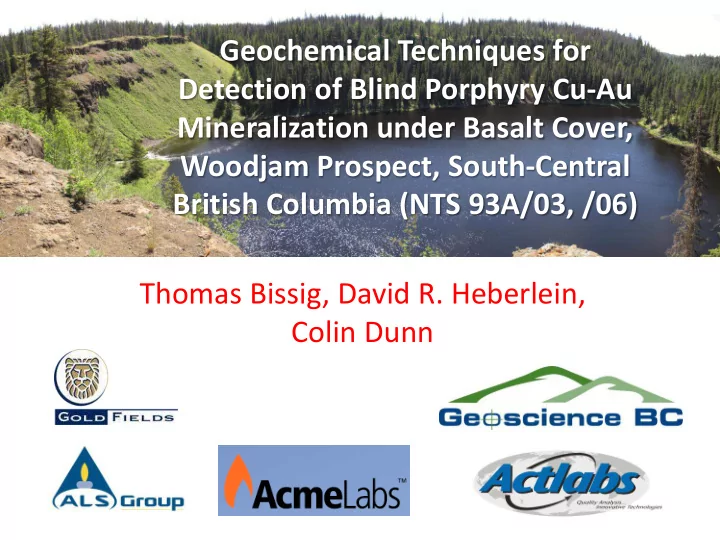

Geochemical Techniques for Detection of Blind Porphyry Cu-Au Mineralization under Basalt Cover, Woodjam Prospect, South-Central British Columbia (NTS 93A/03, /06) Thomas Bissig, David R. Heberlein, Colin Dunn
Statement of the problem Chilcotin Group basalt Alkalic intrusive complex with Cu showings No drilling through basalt into well defined mineralization of any type anywhere in the province ~ 4 km North of Rayfield River Cu
General distribution of basalt cover Given the absence of known mineralization below basalt Woodjam where Cu- Au-Mo mineralization is defined close (within ~ 100 m) to basalt cover Geology from Massey et al. 2005
Research Approach Try everything... • Characterization of basalt substrate • Amygdules in Basalt (Clay and carbonate) • B-horizon soils 7 different leaches • Soil pH and conductivity • Plants (Spruce twigs and bark) • Complemented by exudates, plants, charcoal, Ah horizon data (Heberlein et al. in progress) Colin’s vacuum system Photo D. Heberlein
Some of the techniques Heberlein et al. applied ( which is part of the many things I am NOT going to talk about)
Disclaimer.... What did I get into? 1) It could be all random 2) I really have no idea what I am talking about...
MAG-12-04 MAG-12-04 Geology by Blackwell et al. 2012, Goldfields WIP
Deerhorn section through mineralization Del Real et al. 2013
One of the only places where drilled through basalt into mineralization: Three Firs zone MAG 12 04/04A/05 Thee Firs mineralization ~ 65 m of till ~ 25 m of basalt ~ mineralization Chilcotin basalt
Chilcotin vs. Nicola Group basalt
Amygdule chemistry (Aqua Regia) Samples from drillholes Barren drillhole characterized by paucity of calcite amygdules
B-horizon soils. Weakly developed Podzol, Brunisol, locally Gleysol Ah Ae Bf B-C
Soil pH and conductivity Deerhorn
B-horizon soil geochemistry Deerhorn
Soil Gas Hydrocarbons and Organo Sulfur Geochemistry Copied from standard report provided by Actlabs Sutherland 2012a,b) Roughly coinciding interpretation for anomaly and known mineralization
Vegetation results Deerhorn
Three Firs/ Magalloy
Soil pH and conductivity Three Firs
B-horizon soil geochemistry 3 Firs
Vegetation results Three Firs Pb Au Spruce Bark Spruce Twigs (Ashed) Mo Cs Rb Rb Cs
Interpretation for anomaly and known mineralization not in the same spot. Sample set too small?
Effect of Fe
The situation simplified/interpreted at Three Firs Zn Cu IDH Till Basalt n o i t a z i l a r e n i M Possible reduced chimney
The situation simplified/interpreted at Deerhorn Zn Cu pH IDH ? ? Possible reduced chimneys
What does it all mean.... What works well at Woodjam: Soil pH (IDH) seems to get you close to mineralization B-horizon soil geochemistry seems to be able to detect anomalies related to mineralization. In general: Bioleach > AR/Enzyme Leach > Ionic Leach > 4 Acid (but depends on question and element) Plant geochemical response is subtle but Cs, Rb, K are able to detect potassic alteration over mineralization. Other elements like Cu, Pb, Mo, Au, Se, show only subtle contrast.
What does it all mean.... Basalt is not impermeable to geochemical signal: One “ear of the rabbit” over basalt, the other over till at both Three Firs (several elements) and Deerhorn (Zn) Why should it be anyway? Columnar jointing, porosity.... Ideas and further work (but not planned specifically): Amygdule chemistry expanded Does the presence of calcite amygdules by itself indicate location at the edge of reduced chimney?
Constructive comments are appreciated... Hop tea tasting far beyond Spruce exudate field tasting for anomalies anomalies
Recommend
More recommend